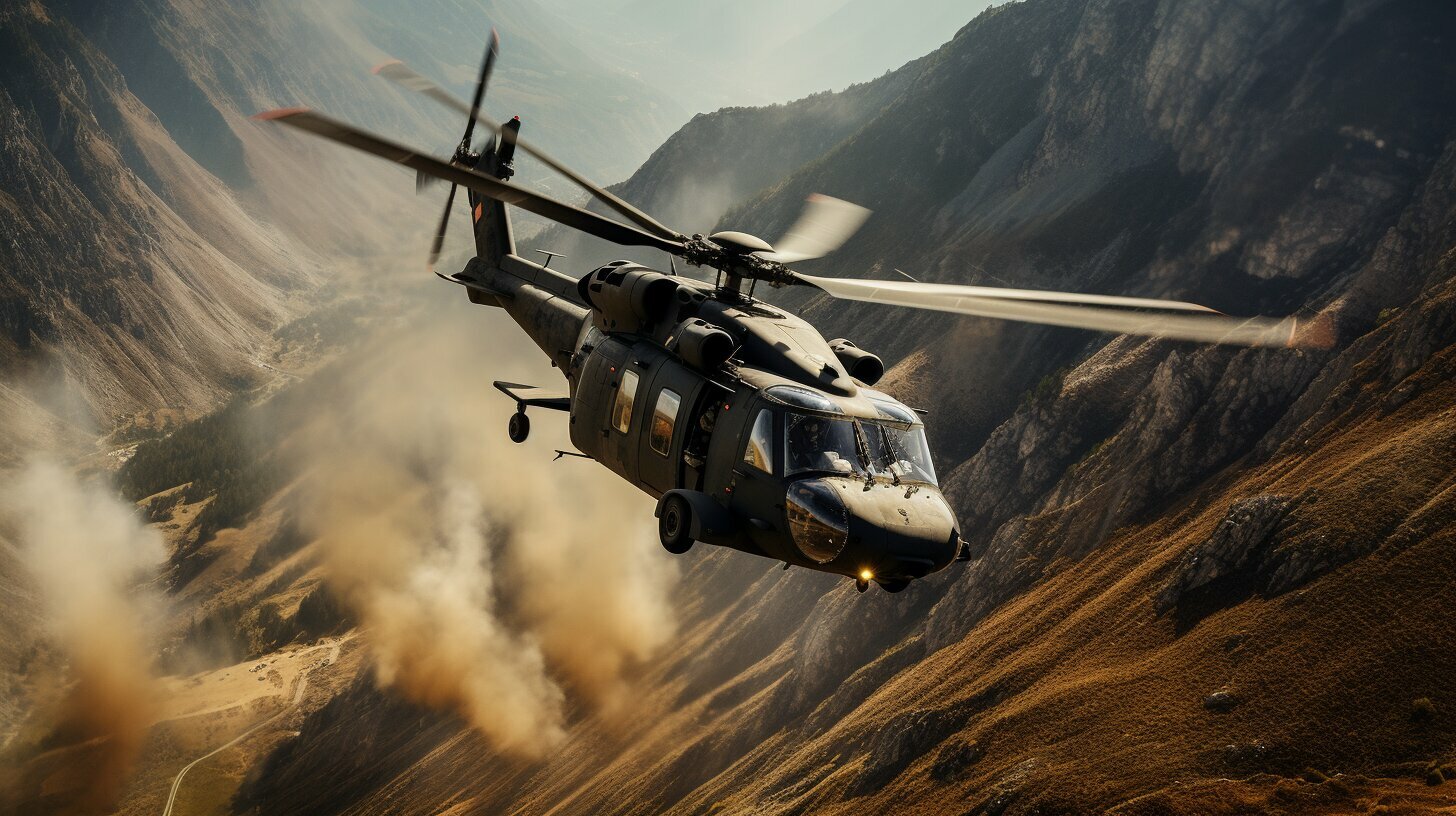
What Can Helicopters Do That Airplanes Cannot?
Helicopters and airplanes are both incredible feats of engineering that enable humans to take to the skies. However, while they have some similarities, they are designed for very different purposes. Helicopters have unique capabilities that airplanes do not, allowing them to perform tasks that would be impossible with fixed-wing aircraft. Here is an in-depth look at what helicopters can do that airplanes cannot.
Vertical Takeoff and Landing
One of the most significant advantages of helicopters over airplanes is their ability to take off and land vertically. Unlike airplanes, helicopters do not require a runway for takeoff and landing. They can take off and land in small clearings or even on top of buildings.
This vertical flight capability allows helicopters to operate in areas inaccessible to airplanes. Helicopters can land in remote locations without an airport nearby. They can set down on oil rigs, hilltops, and rooftops. Helicopters can take off and land in a space not much larger than the helicopter itself. This versatility makes them invaluable for applications like:
- Emergency medical transport – Helicopters allow hospitals to quickly transport patients from scenes of accidents or remote locations. Landing at a trauma scene or on a hospital helipad is much faster than taking a ground ambulance.
- Search and rescue – Helicopters can access mountainsides, forests, and oceans to rescue people in danger. Hikers, skiers, and boaters can be reached via helicopter in terrain a plane could never land.
- Aerial construction – Helicopters can lift beams, air conditioners, and other equipment onto tops of skyscrapers under construction. They can also access remote sites like cell phone towers.
- Offshore oil operations – Crews and supplies are transported to and from oil platforms via helicopter as there are no runways on the open ocean.
- Police operations – Law enforcement helicopters can land almost anywhere to respond quickly to crimes or accidents. They also are used for aerial surveillance.
Airplanes require extensive infrastructure to take off and land. Helicopters free users from this limitation by allowing takeoff and landing anywhere it is safe to operate. This adds enormous flexibility and time savings for many critical operations.
Hovering and Low Speed Capabilities
Another key advantage of helicopters over airplanes is their ability to hover, fly vertically, and operate at very low speeds. The rotating blades of a helicopter allow it to fly straight up and down, forward, backward, and laterally. Some of the unique capabilities this enables include:
- Hovering in place – Helicopters can use their vertical flight to hover and maintain a fixed position. This allows them to operate in confined spaces or provide an aerial platform for tasks. News helicopters hover near events to capture video. Medical helicopters can hover over injured people while lowering medics. Construction helicopters can hover in place while connecting beams.
- Low speed flight – Helicopters can fly slowly or remain nearly motionless relative to the ground. Airplanes need significant forward airspeed to generate lift. Even slow plane speeds of 30-40 mph far exceed the crawl pace at which helicopters can operate.
- Reverse flight – Helicopters can fly backward by changing the pitch of their rotating blades. No airplane can reverse without losing lift and starting to fall.
- Sideways flight – Helicopters can also use their blade control to skid sideways or laterally reposition themselves while hovering. This helps them operate in tight spaces.
- Aerial work platform – The ability to both hover and fly side to side, forward, and back allows helicopters to maintain steady positioning while carrying external loads. This makes them ideal as aerial cranes for tasks like installing tall antennas, cleaning high-rise windows, or planting trees on hillsides. Operators can keep the helicopter positioned exactly where they need it.
These low speed and hovering abilities let helicopters perform tasks impractical with the higher speeds and forward motion requirements of airplanes. They open up operation in tight spaces and provide much more flexibility in achieving precise positioning for aerial work jobs.
Agility and Maneuverability
Helicopters also have greater agility and maneuverability compared to airplanes. Their ability to takeoff and land vertically, hover, and fly sideways, backward and forward gives them an edge in time-sensitive missions with obstacles or confined landing zones.
Some of the maneuvers helicopters can perform include:
- Tight turns in a small radius – Helicopters can pivot and turn in an area not much larger than the helicopter itself. This aids operation in dense, urban environments between buildings. Airplanes require much wider turns.
- Sidestepping between obstacles – Helicopters can use lateral flight to maneuver between vertical obstacles like trees, poles and buildings. Airplanes are more restricted to forward flight paths.
- Backing up – Helicopters can reverse flight to move away from obstacles or inaccurate landings. Airplanes cannot fly backward.
- Rapid changes in direction – Helicopters can swiftly change direction by modifying blade pitch and control inputs. Airplanes must follow more gradual arcing turns.
- Vertical descents – Helicopters can descend straight down through holes in a forest canopy or between buildings. Airplanes cannot descend vertically.
- “Pirouette” maneuver – Helicopters can rotate in place around a target during operations like aerial refueling or lowering rescue equipment. Aircraft must circle around.
This combination of agility and maneuverability gives helicopter pilots more options to access tight landing zones in risky or emergency situations. It also helps them avoid obstacles and operate in confined areas where airplanes could not safely fly.
Slower Stall Speed
Unlike airplanes, helicopters do not depend on forward airspeed over their wings to generate lift. The rotating blades of a helicopter allow it to stay aloft while moving slowly or even while at a standstill hovering in place.
As a result, helicopters have much slower stall speeds compared to airplanes – often less than 60 mph compared to 70-80 mph or faster for light aircraft. And while airplane power failures are catastrophic below stall speed, a helicopter can perform an emergency “autorotation” landing even with complete engine failure by gliding down using its blade inertia.
The slower stall speeds of helicopters provide additional advantages including:
- Increased safety margins – Helicopter pilots have more time to react and recover from emergencies like power loss at lower operating speeds. Airplanes become uncontrollable much sooner if speed drops.
- Safer training – New helicopter pilots can learn to hover and maneuver at safe, low speeds. Airplane students must fly near stall limits to master takeoffs and landings.
- Operating in windy conditions – Helicopters can more safely operate in windy environments like coastal and mountain zones. Airplanes would be pushed toward dangerous stall speeds.
- Using confined landing sites – Helicopters need less runway length to land since they can touch down at slower speeds. Shortsites like rooftops can be accessed.
- Precise positioning – Slower flight allows helicopters more time for maneuvering to exactly the right landing place in tricky missions like urban rescue.
The lower stall speeds increase helicopter utility across a range of flight regimes from training to operations in tight or windy conditions where airplanes would face risks.
Ability to Hover Efficiently
Unlike airplanes which must always be moving forward to fly, helicopters are designed for efficient hovering. The relatively narrow, aerodynamic shape and high load capacity of the rotor blades maximize stationary lift generation. And the powerplants and transmission systems in helicopters provide abundant torque for hovering endurance.
Some examples of tasks enabled by this efficient hovering capability:
- News coverage – Broadcast helicopters can hover in place above news events to provide aerial live footage. Airplanes would burn too much fuel trying to maintain position.
- Medevac operations – Medical helicopters can hover above remote accident scenes while lowering medics and lifting patients. Airplanes could not safely remain in place for ongoing rescue work.
- Construction lifts – Helicopters can carry air conditioning units and other equipment and hover in place during installation. Construction would require much more equipment without this aerial platform capability.
- Firefighting – Helicopters can refill with water while hovering over lakes and rivers. They also stay in place directing water or retardant drops on wildfires. Airplane firefighting would be far less capable without hovering.
- Military missions – Military forces use helicopters’ hovering efficiency for reconnaissance, targeting, cargo delivery, and tactical insertion of troops in combat zones.
With an airplane, pilots could only approximate hovering by circling in a tight orbit. This would waste substantial fuel and make positioning unstable. The helicopter’s efficiency at true hovering enables it to carry out lengthy mission-critical tasks that fixed wing aircraft simply could not perform.
Operates in Remote Areas Without Airstrips
Unlike airplanes which rely on runways and airports for takeoff and landing, helicopters do not require prepared surfaces and ground infrastructure. They can take off and land just about anywhere a cleared area large enough for the rotor diameter can be found.
This gives helicopters unique utility for accessing areas without airport facilities, including:
- Oil, gas, and mining operations – Helicopters transport crews and supplies to and from offshore oil rigs, remote mining sites, and areas still under exploration.
- Tourism – Helicopters provide air tours of landmarks, cities, and regions where ground travel is difficult like the Grand Canyon or Alaska.
- Disaster relief – Helicopters can deliver aid and evacuate people from areas with earthquake damage or other disasters where local airports are unusable.
- Military deployment – Troops can be inserted via helicopters into combat zones lacking friendly airports or airstrips.
- Pilot training – Student helicopter pilots can practice takeoffs and landings nearly anywhere, without requiring airport access.
- Emergency services – Police, medical, and search and rescue helicopters can reach emergencies in regions without aviation facilities.
With a helicopter, pilots enjoy much greater flexibility to take off and land from unimproved sites and areas without aviation infrastructure. This allows access to people and resources across a wider range of the planet’s geography.
Carry Underslung Loads
Unlike fixed-wing aircraft, helicopters have the ability to carry payloads attached below their fuselages. This underslung load capability allows helicopters to perform many transport missions not possible with planes.
Helicopters employ underslung loads for applications like:
- Logging – Helicopters can airlift cut trees from remote forests by dangling cables below their fuselages.
- Construction – Beams, air conditioning units, and other unwieldy assemblies are transported hanging below helicopters.
- Disaster relief – Cargo like food, medical supplies, and vehicles can be delivered by sling load.
- Military – Troops, artillery, and vehicles are underslung by helicopters for deployment or resupply.
- Firefighting – Helicopters refil often from lakes and rivers via a bucket or tank suspended on a cable.
- Search and rescue – Rescuers are lowered down and injured passengers are raised up on lines below helicopters.
- Heavy Lifts – Helicopters underslung exceptionally heavy objects like aircraft or sections of ships that exceed maximum ground transport weights.
Airplanes lack ability to balance external dangling loads far below their wings. Helicopters’ capabilities to underslung carry diverse items revolutionizes aerial logistics for both civil and military users.
Operate in Icy Conditions
Unlike most fixed wing airplanes, helicopters can operate in icy weather conditions including:
- Snow landings – Helicopters can land in snow without need for runway clearing since they require only a small touchdown spot.
- Lower stall speeds – Helicopters have a safety advantage with lower stall speeds compared to airplanes in icy conditions which degrade lift generation.
- Vertical takeoffs – Helicopters avoid the risks of a horizontal airplane takeoff run on slippery ice. They simply lift off vertically from their landing spot.
- De-icing flexibility – Helicopters can more easily land to conduct de-icing operations since they do not rely on prepared runways.
- All-weather capability – Advanced helicopters may have de-icing or anti-icing systems on their rotor blades allowing flight in heavier icing than airplanes.
These capabilities allows helicopters to maintain crucial operations like emergency medical, law enforcement, wilderness search and rescue, and transportation flights through snow events or icy weather which would ground airplane travel.
Operate on Water
Helicopters equipped with floatation gear can takeoff from and land on bodies of water. This gives them unique capabilities including:
- Maritime search and rescue – Helicopter crews can conduct search patterns and lower swimmers or retrieval gear to recover distressed boaters and ships.
- Logistics to island or coastal sites – Helicopters can land offshore to deliver crews and supplies without need for boat transport.
- Underwater survey / sensing – Specialized submersible helicopters can land on water and then dip sonar or sensing gear below the surface.
- Firefighting – Helicopters fitted with floats quickly refill water via designated dip sites along the coast or lakes.
- Open ocean operations – With inflatable floats or pontoons, helicopters can operate away from land bases by setting down on the open sea.
While seaplanes also takeoff from water, helicopters have advantages in their lower stall speeds, hovering capabilities, and ability to hold fixed positions that make water-based operations much more robust than what fixed wing aircraft could accomplish.
Transport Sensitive Payloads
Helicopters offer a smooth ride quality that makes them well-suited for transporting payloads that are fragile, hazardous, or require delicate handling. Their capabilities include:
- Medical patients – Helicopter medevac flights employ smooth trajectories and landings to minimize discomfort for injured people.
- Humanitarian aid – Disaster relief supplies like blood, vaccines, and food can be kept level in low-vibration helicopter underslung loads.
- Explosive / hazardous material transport – Helicopters limit shocks that could detonate explosives or compromise chemical or nuclear cargoes during handling.
- VIP transport – Executives and political leaders often prefer helicopters to airplanes for comfort and land-anywhere flexibility for sensitive trips.
- Wildlife conservation – Helicopters ensure gentle handling when transporting endangered animals or conducting biosampling of fragile organisms.
- Precision equipment – Helicopters limit vibration which allows transporting instruments or components not structurally rated for the higher G-forces experienced in airplane flight.
With their stable hover capability, low speeds, smooth landings, and underslung load configurations, helicopters provide an optimal way to move fragile or precious cargoes safely through the air.
Fly Low Nap-of-the-Earth
Helicopters have unique capabilities to fly contour-hugging, low altitude flight profiles following the details of terrain. Pilots call this low flying just above treetops or urban “canyons” nap-of-the-earth flying.
Some examples of helicopters using nap-of-the-earth flight include:
- Military operations – Nap-of-the-earth flying allows helicopters to use terrain like hills and trees to mask their approach and avoid detection by enemy forces.
- Law enforcement – Police helicopters can covertly follow suspects through cities using buildings and obstacles to stay out of view during surveillance.
- Pipeline / powerline patrol – Crews inspect infrastructure by flying low along pipeline and power corridors vs. making multiple vertical descents in an airplane.
- Cinema filming – Movie directors use helicopter nap-of-the-earth flight to achieve tracking shots.
Tight Turning Radius
The ability to take off vertically gives helicopters an advantage in turning in confined areas. Helicopters can rotate in place around a target, allowing them to orbit in very tight spaces. In contrast, airplanes must fly in larger concentric circles due to their forward speed requirements.
Examples of helicopters exploiting tight turning include:
- Aerial refueling – Helicopters can refuel while orbiting closely around a tanker aircraft, whereas airplanes require a larger radius to rendezvous with the tanker.
- Observation – New crews can circle tightly around points of interest for ongoing surveillance like monitoring traffic or protesting crowds. Airplanes would need a much wider orbit.
- Rescue hoisting – During lifesaving hoist retrievals, helicopters can maintain a tight turn around victims while lowering or raising medics and litters.
- Tactical maneuvering – Military helicopters use tight turning to rapidly acquire and track targets while minimizing exposure to ground threats when operating in combat zones.
The helicopter’s small turning radius expands its capabilities for delicate operations requiring lingering focus on a fixed point below the aircraft.
Operate Close to Ground and Structures
Unlike airplanes, helicopters can perform takeoffs, landings, and flight maneuvers in close proximity to terrain and structures. This allows them unique access for missions like:
- Urban operations – Police helicopters can operate between buildings for surveillance and respond quickly to crimes with landings on city streets.
- Rescue in tight spots – Helicopters can lower medics or hoist gear to retrieve injured people in confined spaces between obstacles like crumpled vehicles in a ravine.
- Construction / logging – Helicopters access congested sites to hoist beams and harvest trees in areas where there is no space for airplane operations.
- External cargo handling – Helicopters can maintain precision positioning adjacent to structures for exterior lift installations that would be impossible with the larger standoff distance required for airplanes.
- Outline observations – Photographers use helicopters to capture unique angles from vantage points skimming along geographic contours.
The helicopter’s slow speeds, maneuverability, and ability to take off and land vertically permit it to operate in close proximity to the ground and human-made structures in ways unavailable to fixed wing aircraft.
Frequently Asked Questions
How are helicopter rotors different from airplane propellers?
Helicopter rotor blades are designed to spin more slowly but generate much higher lift. They aerodynamically control the entire aircraft. Airplane propellers provide forward thrust and their wings separately generate lift.
What happens if a helicopter’s engine fails?
Helicopters can still land safely using an autorotation maneuver that employs the upward flow of air through the rotor to control descent. Airplanes become unflyable if an engine fails.
Why are helicopter blades on top but airplane propellers on front?
Top-mounted helicopter rotors allow the aircraft to balance on central supporting structure and facilitate sideways flight. Airplane propellers are front-mounted to provide forward thrust.
Can helicopters fly upside down like airplanes?
No, helicopters lack the fixed wing and specialized control systems for sustained inverted flight. They can only perform rolls or limited-duration inverted dives.
How much higher speeds do compound helicopters achieve over traditional designs?
New compound helicopters like the Sikorsky S-97 Raider can cruise over 50% faster at speeds of up to 230+ mph vs around 150 mph for traditional helicopters.
Why are airplane wings fixed but helicopter blades rotatable?
Helicopter blades need to rotate to provide lift and control. Airplanes generate lift using fixed wings and have separate movable control surfaces like flaps and ailerons.
How do helicopter rotors not hit each other when spinning?
Modern helicopters have rigid or hingeless rotor systems that dynamically adjust blade spacing to prevent collisions under all flight conditions.
Can a helicopter glide like an airplane with engine failure?
Yes, by using autorotation, helicopters can still glide to a controlled landing without engine power, unlike a fixed wing airplane which requires thrust to avoid a crash.
What allows helicopters to be more maneuverable than airplanes?
Helicopters maneuver by changing blade pitch angle and rotor speed. Airplanes depend more on redirecting airflows over control surfaces which induces slower reaction lag.
Why are helicopter rescues safer in mountains vs. airplanes?
Unlike airplanes, helicopters can takeoff and land vertically without a runway that may be unavailable on steep or forested mountain terrain.






